
- Homepage
- Author
- Aleister Crowley (6)
- Arthur Von Mayer (15)
- Bram Stoker (8)
- Charles Dickens (9)
- Dan Brown (7)
- Dr. Seuss (18)
- Ernest Hemingway (9)
- Frank Herbert (9)
- George Orwell (12)
- Howe, George (6)
- J.k. Rowling (44)
- J.r.r. Tolkien (16)
- Kurban Said (6)
- L. Frank Baum (9)
- Margaret Mitchell (8)
- Mark Twain (8)
- Robert Paul Smith (6)
- Rudyard Kipling (16)
- Stephen King (28)
- Wendell Berry (9)
- Other (2635)
- Binding
- Language
- Region
- Subject
- Americana (30)
- Art & Photography (98)
- Children's (115)
- Cooking (9)
- Exploration & Travel (29)
- History (151)
- Home & Garden (6)
- Illustrated (31)
- Law & Government (8)
- Literature (6)
- Literature & Fiction (504)
- Military & War (18)
- Outdoor & Nature (11)
- Performing Arts (7)
- Philosophy (20)
- Poetry (13)
- Reference (9)
- Science & Medicine (47)
- Self-help (10)
- Sports & Recreation (9)
- Other (1753)
- Type
ALICE IN WONDERLAND, THROUGH THE LOOKING GLASS! (FIRST EDITION/PRINTING!)1872 wade

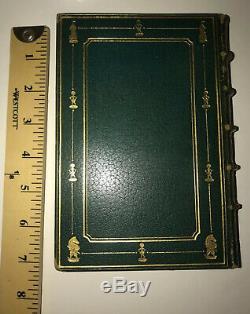
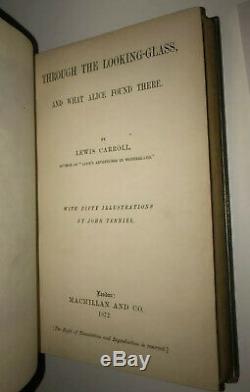
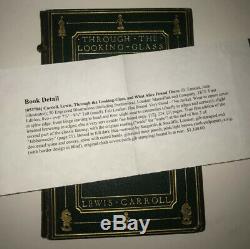
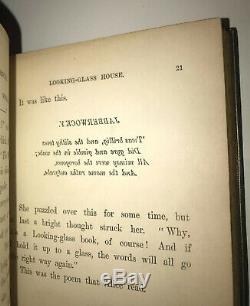
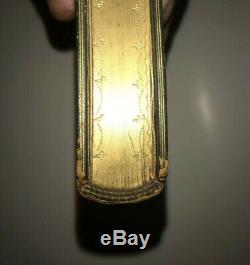
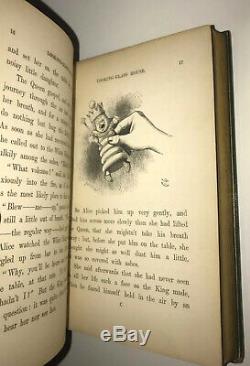
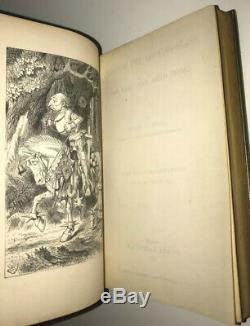
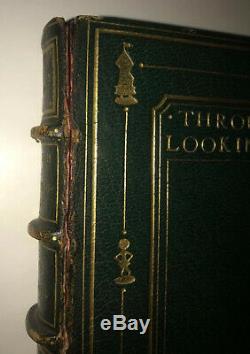

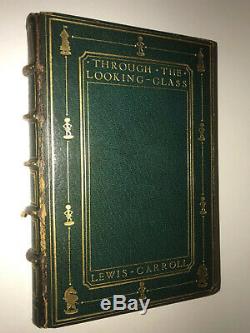
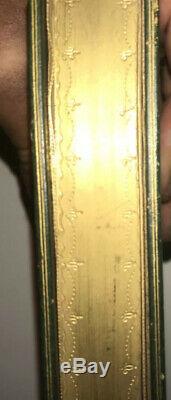


THROUGH THE LOOKING GLASS AND WHAT ALICE FOUND THERE! The Sequel To Alice In Wonderland. FIRST EDITION / FIRST PRINTING. This is the FIRST ISSUE of Through The Looking Glass. With ALL FIRST ISSUE POINTS.
Including the wade error on page 22. This book is almost 150 years old. Thick full leather binding of the highest quality. All edges cased in gold. The fore edges are gauffered, something seldom seen. This is a custom binding. The reason this book is priced so low is due to the abrasion and scuffing, and cracked front hinge. The front hinge is strongly attached but it is cracked. This book is priced low due to the wear to the binding.All edges are cased in thick gilt. More detail is shown in picture #4. This would make an excellent gift and/or addition to any library. Antiquarian books make a great investment, are only going up in value, and are sure to increase the aura of any room or office!
This is the First Printing of Through The Looking Glass. With all required issue points. Printed in 1872, in London. Custom bound in fine leather, with intricate gilded chess pieces. With the original cloth covers bound into the rear.More detail is shown in picture 4. The main condition issue is that the front cover is cracked, and the binding has abrasion and scuffing, hence the low price. A gorgeous binding worthy of gifting!
All edges cased in thick gilt. This is the First Issue, and the most desirable form of this book. It has wear that is reflective in the price.
This is the First Issue with the wade error. This book is priced to sell at cost. As already articulated, this book has condition issues to the binding. From Wikipedia, the free encyclopedia. Upper cover and spine of Pierre Sonnerat.S Voyage to the Spice Islands, bound by Sangorski & Sutcliffe in 1913. Sangorski & Sutcliffe is a firm of bookbinders. It is considered to be one of the most important bookbinding companies of the 20th century, famous for its luxurious jeweled bindings.
That used real gold and precious stones in their book covers. They had met in 1896 at a bookbinding evening classes. At the London County Council.
S Central School of Arts and Crafts. They were employed at Cockerell's own bindery, and began to teach bookbinding at Camberwell College of Art. They were laid off in 1901 after a coal strike. Caused an economic slump, and they decided to set up on their own in a rented attic in Bloomsbury. Starting on 1 October 1901.They soon moved to Vernon Place. And then, in 1905, to Southampton Row.
Sangorski's elder brother, Alberto Sangorski. He became an accomplished calligrapher. They quickly revived the art of jewelled bookbindings. Decorating their sumptuous multi-colour leather book bindings with gold inlay and precious and semi-precious jewels. They were commissioned to create a most luxurious binding of the Rubaiyat of Omar Khayyam.
The front cover of which was adorned with three golden peacocks with jewelled tails and surrounded by heavily tooled and gilded vines, that was sent on the ill-fated RMS Titanic. The book, known as the Great Omar.
Sutcliffe continued the firm, which became recognised as one of the leading bookbinders in London. The bindery moved to Poland Street. And managed to survive through the First World War. In this period, it undertook work for the Ashendene Press. It also created miniature books for Queen Mary's Dolls' House.After Sutcliffe suffered a stroke. In 1936, he entrusted the business to his nephew, Stanley Bray. The company merged with HT Woods.
In 1939, bringing Kenneth Hobson to the firm. He introduced a more modern style of binding. Bray inherited the company on Sutcliffe's death. The firm merged again in 1988, joining with Zaehnsdorf. The combined business was bought by Asprey. In 1985 and renamed SSZ Limited. Shepherds, a bookbinding company, bought the company from Asprey in 1998, and revived the Sangorski & Sutcliffe name.The bindery recently moved from its premises in Bermondsey to Rochester Row. A second copy of the Omar Khayyam was bound as World War II broke out and this was placed in a bank safe vault for safe keeping, but enemy bombing destroyed the vault and the second copy.
Stanley Bray after his retirement made a Third version of the binding using the original design, this is now in the British Library. For other uses, see Through the Looking Glass (disambiguation). First edition cover of Through the Looking-Glass.
Alice's Adventures in Wonderland. Through the Looking-Glass, and What Alice Found There 1871. (also known as "Alice through the Looking-Glass" or simply "Through the Looking-Glass") is a novel by Lewis Carroll. And the sequel to Alice's Adventures in Wonderland.
Alice again enters a fantastical world, this time by climbing through a mirror into the world that she can see beyond it. There she finds that, just like a reflection, everything is reversed, including logic (running helps you remain stationary, walking away from something brings you towards it, chessmen are alive, nursery rhyme characters exist, etc) Through the Looking-Glass includes such verses as Jabberwocky. " and " The Walrus and the Carpenter. , and the episode involving Tweedledum and Tweedledee.
The mirror which inspired Carroll remains displayed in Charlton Kings. The Wasp in a wig. With Alice's Adventures in Wonderland. Alice entering the looking-glass world.
Chapter One Looking-Glass House : Alice. Is playing with a white kitten (whom she calls "Snowdrop") and a black kitten (whom she calls "Kitty") when she ponders what the world is like on the other side of a mirror's reflection. Climbing up onto the fireplace mantel. She pokes at the wall-hung mirror behind the fireplace and discovers, to her surprise, that she is able to step through it to an alternative world.In this reflected version of her own house, she finds a book with looking-glass poetry, Jabberwocky. She can read only by holding it up to the mirror. She also observes that the chess pieces. Chapter Two The Garden of Live Flowers : Upon leaving the house (where it had been a cold, snowy night), she enters a sunny spring garden where the flowers can speak; they perceive Alice as being a "flower that can move about". Elsewhere in the garden, Alice meets the Red Queen.
Who is now human-sized, and who impresses Alice with her ability to run at breathtaking speeds. Chapter Three Looking-Glass Insects : The Red Queen reveals to Alice that the entire countryside is laid out in squares, like a gigantic chessboard, and offers to make Alice a queen if she can move all the way to the eighth rank/row in a chess match. Alice is placed in the second rank as one of the White Queen's. And begins her journey across the chessboard by boarding a train that jumps over the third row and directly into the fourth rank, thus acting on the rule that pawns can advance two spaces on their first move. She arrives in a forest where a depressed gnat teaches her about the looking glass insects, strange creatures part bug part object e.
Bread and butterfly, rocking horse fly, before flying away sadly. Alice continues her journey and along the way, crosses the "wood where things have no names". There she forgets all nouns, including her own name. With the help of a fawn who has also forgotten his identity, she makes it to the other side, where they both remember everything. Realizing that he is a fawn, she is a human, and that fawns are afraid of humans, it runs off (to Alice's frustration). Tweedledum (centre) and Tweedledee (right).Chapter Four Tweedledum and Tweedledee : She then meets the fat twin brothers Tweedledum and Tweedledee. Who she knows from the nursery rhyme. After reciting the long poem The Walrus and the Carpenter.
, they draw Alice's attention to the Red King. Loudly snoring away under a nearby treeand maliciously provoke her with idle philosophical banter that she exists only as an imaginary figure. In the Red King's dreams. Finally, the brothers begin suiting up for battle, only to be frightened away by an enormous crow, as the nursery rhyme about them predicts. Chapter Five Wool and Water : Alice next meets the White Queen.
Who is very absent-minded but boasts of (and demonstrates) her ability to remember future events. Alice and the White Queen advance into the chessboard's fifth rank by crossing over a brook together, but at the very moment of the crossing, the Queen transforms into a talking Sheep. Alice soon finds herself struggling to handle the oars of a small rowboat, where the Sheep annoys her with (seemingly) nonsensical shouting about crabs. Chapter Six Humpty Dumpty : After crossing yet another brook into the sixth rank, Alice immediately encounters Humpty Dumpty. Who, besides celebrating his unbirthday.Provides his own translation of the strange terms in "Jabberwocky". In the process, he introduces Alice to the concept of portmanteau. Words, before his inevitable fall. Chapter Seven The Lion and the Unicorn : "All the king's horses and all the king's men" come to Humpty Dumpty's assistance, and are accompanied by the White King.
Along with the Lion and the Unicorn. Who again proceed to act out a nursery rhyme by fighting with each other. In this chapter, the March Hare. Of the first book make a brief re-appearance in the guise of Anglo-Saxon.
Messengers" called "Haigha" and "Hatta. Chapter Eight "It's my own Invention" : Upon leaving the Lion and Unicorn to their fight, Alice reaches the seventh rank by crossing another brook into the forested territory of the Red Knight, who is intent on capturing the "white pawn"Aliceuntil the White Knight. Escorting her through the forest towards the final brook-crossing, the Knight recites a long poem of his own composition called Haddocks' Eyes. And repeatedly falls off his horse. She soon finds herself in the company of both the White and Red Queens, who relentlessly confound Alice by using word play. To thwart her attempts at logical discussion. They then invite one another to a party that will be hosted by the newly crowned Aliceof which Alice herself had no prior knowledge. Chapter Ten Shaking : Alice arrives and seats herself at her own party, which quickly turns into chaos. Alice finally grabs the Red Queen, believing her to be responsible for all the day's nonsense, and begins shaking her. Chapter Eleven Waking : Alice awakes in her armchair to find herself holding the black kitten, who she deduces to have been the Red Queen all along, with the white kitten having been the White Queen.Chapter Twelve Which dreamed it? The story ends with Alice recalling the speculation of the Tweedle brothers, that everything may have been a dream of the Red King, and that Alice might herself be no more than a figment of his imagination. The book ends with the line Life, what is it but a dream? Statue of Alice passing through the looking glass, by Jeanne Argent, in the grounds of Guildford Castle.
The Lion and the Unicorn. The Walrus and the Carpenter. Main article: List of minor characters in.
The themes and settings of Through the Looking-Glass make it a kind of mirror image. Of Wonderland : the first book begins outdoors, in the warm month of May (4 May). Uses frequent changes in size as a plot device. And draws on the imagery of playing cards; the second opens indoors on a snowy, wintry night exactly six months later, on 4 November the day before Guy Fawkes Night. Uses frequent changes in time and spatial directions as a plot device, and draws on the imagery of chess.
In it, there are many mirror themes, including opposites, time running backwards, and so on. The White Queen offers to hire Alice as her lady's maid and to pay her Twopence a week, and jam every other day. " Alice says that she doesn't want any jam today, and the Queen tells her: "You couldn't have it if you did want it. The rule is, jam tomorrow and jam yesterdaybut never jam to-day.
This is a reference to the rule in Latin that the word iam or jam meaning now in the sense of already or at that time cannot be used to describe now in the present, which is nunc in Latin. Jam is therefore never available today. You can help by adding to it.Lewis Carroll's diagram of the story as a chess game. Whereas the first book has the deck of playing cards as a theme, Through the Looking-Glass is based on a game of chess, played on a giant chessboard with fields for squares. Most of the main characters are represented by a chess piece, with Alice being a pawn.
The looking-glass world is divided into sections by brooks or streams, with the crossing of each brook usually signifying a change in the scene, and corresponding to Alice advancing by one square. Furthermore, since the brook-crossings do not always correspond to the beginning and ends of chapters, most editions of the book visually represent the crossings by breaking the text with several lines of asterisks . The sequence of moves (white and red) is not always followed. The most extensive treatment of the chess motif in Carroll's novel is provided in Glen Downey. S The Truth About Pawn Promotion: The Development of the Chess Motif in Victorian Fiction. To the Looking-Glass world it was Alice that said.. Tune for To the Looking-Glass world it was Alice that said.. Prelude ("Child of the pure unclouded brow"). Seen in the mirror-house; full poem here. The Walrus and the Carpenter. In Winter when the fields are white... The Lion and the Unicorn. / The Aged Aged Man / Ways and Means / A-sitting on a Gate, the song is A-sitting on a Gate, but its other names and callings are placed above.Hush-a-by lady, in Alice's lap.. To the Looking-Glass world it was Alice that said..
A boat beneath a sunny sky. Is the first line of a titleless acrostic. Poem at the end of the bookthe beginning letters of each line, when put together, spell Alice Pleasance Liddell. Lewis Carroll decided to suppress a scene involving what was described as "a wasp in a wig" (possibly a play on the commonplace expression "bee in the bonnet").
It has been suggested in a biography by Carroll's nephew, Stuart Dodgson Collingwood, that one of the reasons for this suppression was a suggestion from his illustrator, John Tenniel. Who wrote in a letter to Carroll dated 1 June 1870. For many years no one had any idea what this missing section was or whether it had survived. The catalogue description read, in part, that The proofs were bought at the sale of the author's... The contents were subsequently published in Martin Gardner's The Annotated Alice.
The Definitive Edition , and is also available as a hardback book The Wasp in a Wig: A Suppressed Episode... The rediscovered section describes Alice's encounter with a wasp wearing a yellow wig, and includes a full previously unpublished poem. If included in the book, it would have followed, or been included at the end of, Chapter 8 the chapter featuring the encounter with the White Knight. The discovery is generally accepted as genuine, but the proofs have yet to receive any physical examination to establish age and authenticity.
The book has been adapted several times, in combination with Alice's Adventures in Wonderland and as a stand-alone film or television special. Live action and animated versions and radio adaptations.
One of the earliest adaptations was a silent movie. Alice Through a Looking Glass , in 1928. A dramatised version directed by Douglas Cleverdon.
Was recorded in the late 1950s by Argo Records. Musical versions include the 1966 TV musical with songs by Moose Charlap. In the role of Alice. A Christmas 2007 multimedia stage adaptation at The Tobacco Factory. Directed and conceived by Andy Burden, written by Hattie Naylor, music and lyrics by Paul Dodgson and a 2008 opera Through the Looking Glass.
Television versions include the 1973 BBC. TV movie, Alice Through the Looking Glass , with Sarah Sutton. A 1982 38-minute Soviet cutout-animated. Studio and directed by Yefrem Pruzhanskiy. In 1987, with Janet Waldo.
As the voice of Alice Mr. Was the voice of the Jabberwock.
And the 1998 Channel 4. TV movie, with Kate Beckinsale.
Playing the role of Alice. This production restored the lost "Wasp in a Wig" episode.
In March 2011, Japanese companies Toei. Announced that a collaborative animation project based on Through the Looking-Glass tentatively titled Kys Giga. On 22 December 2011, BBC Radio 4.
Broadcast an adaptation by Stephen Wyatt. As Lewis Carroll (who not only narrates the story but is also an active character), Carole Boyd. As the Red Queen, Sally Phillips. As the White Queen, Nicholas Parsons. As Tweedledum and Tweedledee and John Rowe.
Adaptations combined with Alice's Adventures in Wonderland include the 1933 live-action movie Alice in Wonderland. It featured most of the elements from Through the Looking Glass as well, including W. As Humpty Dumpty, and a Harman-Ising. Animated version of The Walrus and the Carpenter.
Also features several elements from Through the Looking-Glass , including the talking flowers, Tweedledee and Tweedledum, and "The Walrus and the Carpenter". Another adaptation, Alice's Adventures in Wonderland.
Produced by Joseph Shaftel Productions in 1972 with Fiona Fullerton. As Alice, included the twins Fred and Frank Cox.The 2010 film Alice in Wonderland. Contains elements of both Alice's Adventures in Wonderland and Through the Looking-Glass. The 1974 Italian TV series Nel Mondo Di Alice (In the World of Alice) which covers both novels, covers Through the Looking-Glass in episodes 3 and 4. Combined stage productions include the 1980 version, produced and written by Elizabeth Swados.
Alice in Concert (aka Alice at the Palace), performed on a bare stage. Played the role of Alice, with additional supporting cast by Mark Linn-Baker. In 2007, Chicago-based Lookingglass Theater Company debuted an acrobatic interpretation of Alice's Adventures in Wonderland and Through the Looking Glass with Lookingglass Alice.
Lookingglass Alice was performed in New York City, Philadelphia. And in a version of the show which toured the United States. Iris Theatre in London, England, had a 2 part version of both novels in which Through the Looking-Glass was part 2. Alice was played in both parts by Laura Wickham. It was staged in the summer of 2013. Laura Wade's Alice, a modern adaptation of both books premiering at the Crucible Theatre.In Sheffield in 2010, adapted parts of both novels. By Moira Buffini and Damon Albarn takes some characters from the second novel, notably Dum and Dee and Humpty Dumpty. The show also merges the Queen of Hearts and the Red Queen into one character.
S Alice in Wonderland and Through the Looking-Glass adaptation. For the Royal Shakespeare Company. Adapted through the Looking-Glass in act 2. The 1985 two-part TV musical Alice in Wonderland.
Covers both books; Alice was played by Natalie Gregory. In this adaptation, the Jabberwock materialises into reality after Alice reads "Jabberwocky", and pursues her through the second half of the musical. The 1999 made-for-TV Hallmark/NBC film Alice in Wonderland. As Alice, merges elements from Through the Looking Glass including the talking flowers, Tweedledee and Tweedledum, "The Walrus and the Carpenter", and the chess theme including the snoring Red King and White Knight. Contains elements from Alice's Adventures in Wonderland and Through the Looking-Glass.
The item "ALICE IN WONDERLAND, THROUGH THE LOOKING GLASS!)1872 wade" is in sale since Wednesday, April 15, 2020.
This item is in the category "Books\Antiquarian & Collectible". The seller is "merchants-rare-books" and is located in Moab, Utah. This item can be shipped worldwide.- Publisher: Macmillan
- Character Family: Alice in Wonderland
- Modified Item: No
- Subject: Literature & Fiction
- Place of Publication: London
- Topic: Alice In Wonderland
- Author: Lewis Carrol
- Year Printed: 1872
- Language: English
- Special Attributes: Custom Bound
- Original/Facsimile: Original
- Binding: Leather

